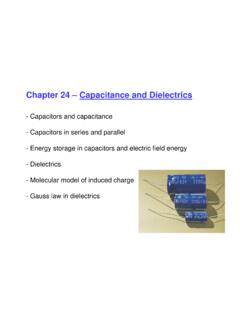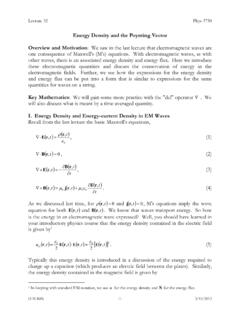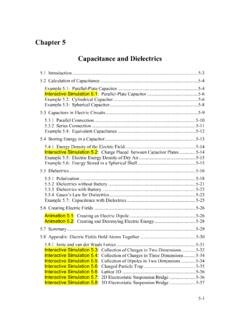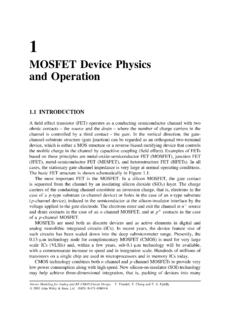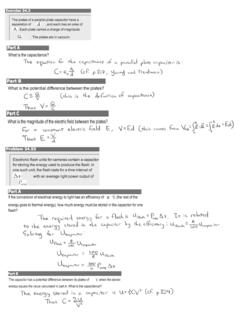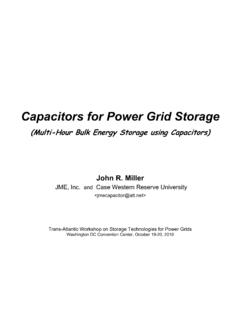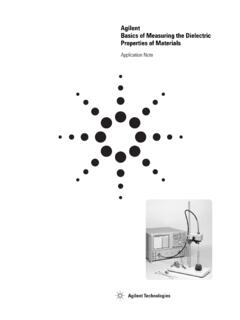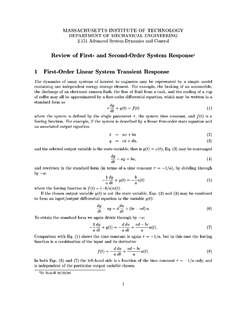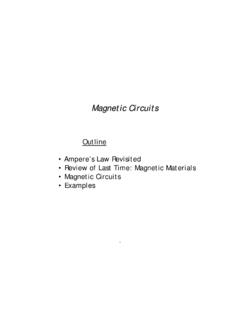Transcription of Capacitor with Dielectric - University of Rhode Island
1 Capacitor with DielectricMost capacitors have a Dielectric (insulating solid or liquid material) in the space between theconductors. This has several advantages: Physical separation of the conductors. Prevention of Dielectric breakdown. Enhancement of Dielectric is polarized by the electric field between thecapacitor [tsl124 1/13]Parallel-Plate Capacitor with Dielectric (1)The polarization produces a bound charge on the surface of the Dielectric .++++++++++++++++ ++++++++++++++++ ++++++++ +qf qf+qf qb+qb qfE0 EThe bound surface charge has the effect of reducing the electric field between the plates from~E0to~E.
2 A: area of plates d: separation between plates qf: free charge on plate qb: bound charge on surface of Dielectric ~E0: electric field in vacuum ~E: electric field in dielectric14/9/2015[tsl125 2/13]Parallel-Plate Capacitor with Dielectric (2)Use Gauss law to determine the electric fields~E0and~E.++++++++++++++++ ++++++++++++++++ ++++++++ +qf qf+qf qb+qb qfE0E Field in vacuum:E0A=qf 0 E0=qf 0A Field in Dielectric :EA=qf qb 0 E=qf qb 0A< E0 Voltage:V0=E0d(vacuum),V=Ed=V0 < V0( Dielectric ) Dielectric constant: E0E=qfqf qb> of Dielectric : = [tsl126 3/13] Dielectric Materials Dielectrics increase the capacitance:C/C0=.
3 The Capacitor is discharged spontaneously across the Dielectric if the electric field exceedsthe value quoted as Dielectric [tsl138 4/13]Impact of Dielectric (1)What happens when a Dielectric is placed into a capacitorwith thecharge on the capacitorkept constant?vacuumdielectricchargeQ0Q=Q0ele ctric fieldE0E=E0 < E0voltageV0V=V0 < V0capacitanceC0=Q0V0C=QV= C0> C0potential energyU0=Q202C0U=Q22C=U0 < U0energy densityu(0)E=12 0E20uE=u(0)E =12 0E2< u(0)E14/9/2015[tsl127 5/13]Impact of Dielectric (2)What happens when a Dielectric is placed into a capacitorwith thevoltage across the capacitorkept constant?vacuumdielectricchargeQ0Q= Q0electric fieldE0E=E0voltageV0V=V0capacitanceC0=Q0V0C=QV= C0> C0potential energyU0=12C0V20U=12CV2= U0> U0energy densityu(0)E=12 0E20uE= u(0)E=12 0E2> u(0)E14/9/2015[tsl128 6/13]Stacked DielectricsConsider a parallel-plate Capacitor with areaAof each plate and spacingd.
4 Capacitance without Dielectric :C0= 0Ad. Dielectrics stacked in parallel:C=C1+C2withC1= 1 0A/2d, C2= 2 0A/2d. C=12( 1+ 2)C0. Dielectrics stacked in series:1C=1C1+1C2withC1= 1 0Ad/2, C2= 2 0Ad/2 C=2 1 2 1+ [tsl129 7/13]Lateral Force on DielectricConsider two charged capacitors with dielectrics only halfway between the configuration (a) any lateral motion of the Dielectric takes placeatconstant voltageacross the configuration (b) any lateral motion of the Dielectric takes placeatconstant chargeon the in each case the direction (left/zero/right) of the lateral force experienced by thedielectric.(b)(a)14/9/2015[tsl130 8/13]Geiger CounterRadioactive atomic nuclei produce high-energy particles of three different kinds: -particles are4He nuclei.
5 -particles are electrons orpositrons. -particles are high-energyphotons. loudspeakerlow pressureamplifierinert gas Free electrons produced by ionizing radiation are stronglyaccelerated toward the central wire. Collisions with gas atoms produce further free electrons, which are accelerated in the samedirection. An avalanche of electrons reaching the wire produces a current pulse in the [tsl123 9/13]Intermediate Exam II: Problem #1 (Spring 05)The circuit of capacitors connected to a battery is at equilibrium.(a) Find the equivalent capacitanceCeq.(b) Find the voltageV3across capacitorC3.(c) Find the the chargeQ2on = 22CF C1F = 33C= 114/9/2015[tsl336 10/13]Intermediate Exam II: Problem #1 (Spring 05)The circuit of capacitors connected to a battery is at equilibrium.
6 (a) Find the equivalent capacitanceCeq.(b) Find the voltageV3across capacitorC3.(c) Find the the chargeQ2on = 22CF C1F = 33C= 1 Solution:(a)C12=C1+C2= 3 F, Ceq= 1C12+1C3 1= [tsl336 10/13]Intermediate Exam II: Problem #1 (Spring 05)The circuit of capacitors connected to a battery is at equilibrium.(a) Find the equivalent capacitanceCeq.(b) Find the voltageV3across capacitorC3.(c) Find the the chargeQ2on = 22CF C1F = 33C= 1 Solution:(a)C12=C1+C2= 3 F, Ceq= 1C12+1C3 1= F.(b)Q3=Q12=Qeq=Ceq(8V) = 12 C V3=Q3C3=12 C3 F= [tsl336 10/13]Intermediate Exam II: Problem #1 (Spring 05)The circuit of capacitors connected to a battery is at equilibrium.
7 (a) Find the equivalent capacitanceCeq.(b) Find the voltageV3across capacitorC3.(c) Find the the chargeQ2on = 22CF C1F = 33C= 1 Solution:(a)C12=C1+C2= 3 F, Ceq= 1C12+1C3 1= F.(b)Q3=Q12=Qeq=Ceq(8V) = 12 C V3=Q3C3=12 C3 F= 4V.(c)Q2=V2C2= 8 [tsl336 10/13]Unit Exam II: Problem #1 (Spring 07)Consider the configuration of two point charges as shown.(a) Find the energyU3stored on capacitorC3.(b) Find the voltageV4across capacitorC4.(c) Find the voltageV2across capacitorC2.(d) Find the chargeQ1on 3 FF = 54CF = 22CF = 21C14/9/2015[tsl362 11/13]Unit Exam II: Problem #1 (Spring 07)Consider the configuration of two point charges as shown.
8 (a) Find the energyU3stored on capacitorC3.(b) Find the voltageV4across capacitorC4.(c) Find the voltageV2across capacitorC2.(d) Find the chargeQ1on 3 FF = 54CF = 22CF = 21 CSolution:(a)U3=12(3 F)(6V)2= 54 [tsl362 11/13]Unit Exam II: Problem #1 (Spring 07)Consider the configuration of two point charges as shown.(a) Find the energyU3stored on capacitorC3.(b) Find the voltageV4across capacitorC4.(c) Find the voltageV2across capacitorC2.(d) Find the chargeQ1on 3 FF = 54CF = 22CF = 21 CSolution:(a)U3=12(3 F)(6V)2= 54 J.(b)V4= [tsl362 11/13]Unit Exam II: Problem #1 (Spring 07)Consider the configuration of two point charges as shown.
9 (a) Find the energyU3stored on capacitorC3.(b) Find the voltageV4across capacitorC4.(c) Find the voltageV2across capacitorC2.(d) Find the chargeQ1on 3 FF = 54CF = 22CF = 21 CSolution:(a)U3=12(3 F)(6V)2= 54 J.(b)V4= 6V.(c)V2=126V = [tsl362 11/13]Unit Exam II: Problem #1 (Spring 07)Consider the configuration of two point charges as shown.(a) Find the energyU3stored on capacitorC3.(b) Find the voltageV4across capacitorC4.(c) Find the voltageV2across capacitorC2.(d) Find the chargeQ1on 3 FF = 54CF = 22CF = 21 CSolution:(a)U3=12(3 F)(6V)2= 54 J.(b)V4= 6V.(c)V2=126V = 3V.(d)Q1= (2 F)(3V) = 6 [tsl362 11/13]Unit Exam II: Problem #1 (Spring 08)The circuit of capacitors is at equilibrium.
10 (a) Find the chargeQ1on Capacitor 1 and the chargeQ2on Capacitor 2.(b) Find the voltageV1across Capacitor 1 and the voltageV2across Capacitor 2.(c) Find the chargeQ3and the energyU3on Capacitor 5 FC2C1= 6 F= 12 F14/9/2015[tsl377 12/13]Unit Exam II: Problem #1 (Spring 08)The circuit of capacitors is at equilibrium.(a) Find the chargeQ1on Capacitor 1 and the chargeQ2on Capacitor 2.(b) Find the voltageV1across Capacitor 1 and the voltageV2across Capacitor 2.(c) Find the chargeQ3and the energyU3on Capacitor 5 FC2C1= 6 F= 12 FSolution:(a)C12= 16 F+112 F 1= 4 F,Q1=Q2=Q12= (4 F)(12V) = 48 [tsl377 12/13]Unit Exam II: Problem #1 (Spring 08)The circuit of capacitors is at equilibrium.

